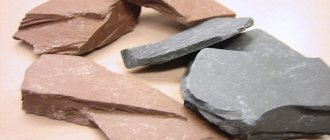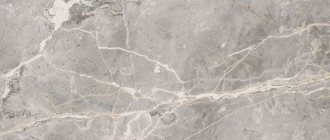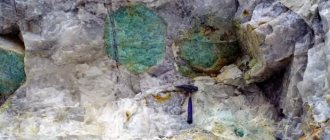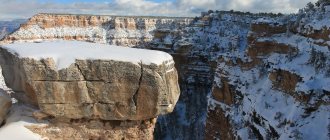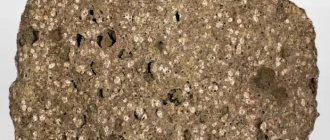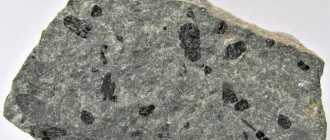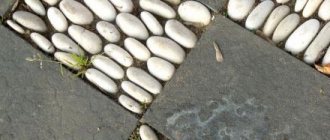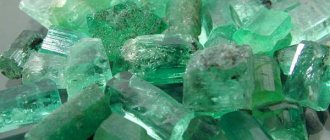Definition
Gneiss is usually called a metamorphic rock, that is, formed in the bowels of the Earth. Metamorphism is understood as the transformation of sedimentary and igneous natural mineral formations as a result of changes in physical and chemical conditions (temperature, pressure, exposure to various gas and aqueous solutions). Such processes occur due to vibrations of the earth's crust and other processes occurring in them. As a result, various transformations occur and metamorphic rocks are formed. Gneiss is often characterized by a distinct parallel-schistose, often finely banded texture.
The grain sizes of the mineral are usually greater than 0.2 mm. These granular crystalline formations are rich in feldspar and are usually represented by quartz, muscovite, biotite and other minerals. Among the colors, light shades predominate (gray, red and others).
Gneiss is one of the most common metamorphic rocks, a very popular and practical finishing material in construction. It looks like a compacted round piece with a rough and uneven surface. It has great strength and can withstand large temperature ranges. These physical and mechanical properties determine long-term, reliable and aesthetic results in construction, when cladding buildings and sidewalks, and when decorating interiors.
Links[edit]
Quotes [edit]
- Harper, Internet Etym.
Dict. , "gneiss" - ^ abcde Marshak 2013, pp. 194–95; Rice. 7.6a–c
- Bags & Secor (1990).
- Björn Hageskov (1985): Constrictional deformation of a dyke swarm of a ductile left-lateral shear zone at Koster, Koster Islands, SW Sweden. Bulletin of the Geological Society of Denmark 34(3–4): 151–97
- Gillen (2003), p. 44.
- McKirdy et al (2007), p. 95.
Bibliography[edit]
- Blatt, Harvey and Robert J. Tracy (1996). Petrology: Igneous, Sedimentary and Metamorphic
, 2nd ed. Freeman, pp. 359–65. ISBN 0-7167-2438-3. - Gillen, Cohn (2003). Geology and Landscapes of Scotland
. Harpenden. Terra Publishing. ISBN 1-903544-09-2. - Harper, Douglas (ed.). "gneiss", Internet Etymological Dictionary
. Retrieved March 1, 2015. - Marshak, Stephen (2013). Fundamentals of Geology
(4th ed.). WW Norton. ISBN 978-0-393-91939-4.CS1 maint: ref=harv (link) - McKirdy, Alan, Roger Crofts and John Gordon (2007). A Land of Mountains and Floods: The Geology and Landforms of Scotland
. Edinburgh. Birlinn. ISBN 978-1-84158-357-0. - Murray, W. H. (1966). Hebrides
. London. Heinemann. - Sachs, Paul E. and Donald T. Secor (1990). "Kinematics of the Late Paleozoic continental collision of Laurentia and Gondwana". Science
,
250
(4988): 1702–05. DOI: 10.1126/science.250.4988.1702.
Terminology problem
In the scientific community, controversy arose over the question of what rocks gneiss belongs to. Some researchers (Levinson-Lessing, Polovinkina, Sudovikov) believed that quartz must certainly be present here. Other scientists (Saranchina, Shinkarev) put forward a different point of view, according to which the rock is abundant in feldspars and also includes quartz. That is, in the second option, the presence of quartz is not necessary.
However, the first interpretation is close to its original interpretation, when this term denoted only shales that correspond in mineral composition to granites. That is, quartz is still a typomorphic, defining mineral in the composition of gneisses.
How to identify
In color, chemical properties, and composition, gneiss as a rock is close to granite.
“Gneiss” characteristics help to distinguish it from others:
- Granular-schistose structure (granite has granular structure).
- Texture: longitudinally slatey or resembling thin stripes.
- Presence of quartz, feldspar.
In addition, gneisses are not as dense and have a stronger shine.
Hypotheses about education
The origin of the gneiss rock is still unclear in our time, although there are several dozen scientific assumptions, as well as many literary sources touching on this topic. Nevertheless, all judgments agree on certain basic opinions. For example, that the emergence of gneisses is determined by the processes of deep metamorphism of various rocks.
Some petrologists consider gneiss as fragments of the primordial earth's crust, which covered the planet as it cooled and changed its state of aggregation from fiery liquid to solid. There is also an assumption that these are igneous rocks that, as a result of metamorphism, acquired layering. Still others consider gneisses to be a chemical sediment of the primordial ocean, which crystallized under high atmospheric pressure from superheated water. Still others see them as sedimentary rocks that have been altered over thousands of years by the heat of the earth, pressure and the activity of groundwater.
There is another hypothesis, according to which gneisses are sedimentary rocks that crystallized during or shortly after their deposition in the earth's crust. It is believed that the most impressive formation of gneisses in the history of the Earth occurred about 2.5-2.0 billion years ago.
What is
Gneiss is a metamorphic rock, one of the most common on Earth.
It is literally the foundation of the planet: together with granites, it formed the foundations of the European, North American, and East Siberian continental plates. These ancient formations are the result of tectonic processes that shook the Earth's lithosphere more than 4 billion years ago.
The term goes back to a consonant Old German, but there is no consensus:
- Since the Middle Ages, local miners have called loose rock in a dense massif Gneis.
- The word Gneist meant “spark” (after all, the stone glitters).
It has been circulating in Europe as a mineralogical term since the mid-18th century.
Composition and structure
Gneiss refers to rocks that are characterized by a banded texture, resulting from the alternating arrangement of light and dark minerals. The color is usually light. Main components: quartz, feldspar and others.
The chemical composition is close to granites and shales and is varied. As a rule, this is 60-75% silicic acid, 10-15% alumina and in a small volume iron oxide, lime, Mg, K, Na and H2O.
Physical parameters are very dependent on the structure and level of foliation. The density characteristic is 2600-2900 kg/m3, the proportion of pore volume in the total volume is 0.5-3.0%.
Based on the mineral components, it is customary to distinguish between biotite, muscovite gneisses, and so on. According to their structure, they can be, for example, tree-like, spectacled, or ribbon-like.
Based on the type of parent rocks, there is a division into para- and orthogneisses. The former arise as a result of changes in sedimentary rocks; the latter - due to modification of igneous (usually volcanogenic) rocks.
A typical feature of the gneiss rock is foliation, which has different characteristics. It represents either a remnant of the primary layering of sedimentary rocks, or is an intrusion.
Physico-chemical properties of stone
Externally, the stone is easy to distinguish from granite due to its layering. The layers are not always clearly visible: sometimes they are thick and have difficult-to-see boundaries. If the degree of transformation of the granite rock is low, then it can be difficult to recognize gneiss from small fragments.
The color of the stone is usually close to gray or brown. There are pinkish, greenish and reddish colors.
The texture is finely striped or parallel-banded. The hardness that gneiss has depends on the minerals it contains.
The mineral is distinguished by high density (up to 2900 kg/m3), as well as low rates of water absorption (up to 2%) and porosity (up to 3%). The specific gravity reaches 2.87 g/cm3.
Composition: apatite, feldspar, kyanite, quartz, garnet, mica, and sometimes hornblende. Chemical composition: SiO2 68–72%, Al2O3 15–18%, Na2O 3–6%, Fe3O4 1–5%, CaO 1.5–4%, MgO 1.5%.
Varieties
The division of gneisses into different types is due to the diversity of mineralogical and elemental composition, the degree of granularity (structural features) and the location of grains in the rock (textural characteristics).
As a result of the transformation of sedimentary rocks, alumina-rich gneisses are formed, often including garnet and andalusite (high-alumina).
Rocks with a porphyroblastic texture, in which usually round or ellipsoidal feldspar porphyroblasts (sometimes together with quartz) are visible in the form of eyes in cross section, are called spectacled.
Complex metamorphic formations of mixed structure, penetrated by granitic material, including its veins, are called migmatites.
Gneiss can consist of several minerals: biotite, muscovite, diopside and others. Some varieties of gneisses have their own names, such as charnockites and enderbites.
In addition, separation according to the type of initial rocks is widely used. Gneiss as an igneous rock is represented by orthogneiss, which arose as a result of the transformation of igneous rocks (for example, granites). It is believed that their main initial source is volcanic eruptions. Paragneisses are a consequence of deep metamorphism of sedimentary rocks.
Price
Gneiss stone with characteristic features of the rock is sold for an average of 15 rubles. for every. Varieties of gneiss used for cladding can be purchased from 230 rubles. per sq. The cost varies depending on the appearance, parameters and texture of the slabs. Small columnar fragments of this rock for decorating aquariums cost 12,000 rubles. per kg.
Often, building materials made from gneiss are sold at the cost of granite. If there are no characteristic stripes on the gneiss, it is practically impossible to distinguish it from granite. Sometimes professional stone carvers extract the best layer from it, which is then sold as high-grade granite.
In an industry such as “trading,” any rock with visible, intertwined grains of feldspar is considered “granite.” The sight of gneisses and other rocks sold as "granite" worries many geologists. However, this long-standing practice of trading size stones simplifies discussions with clients, since not everyone knows the technical names of unusual igneous and metamorphic rocks.
Relationship between gneiss and granite
Gneiss is a commonly found rock composed of feldspar, quartz and mica. Similar components are characteristic of granite, but there is a fundamental difference. It lies in the fact that in granite there is no clear distribution of its constituent components. In gneiss, all the minerals are located parallel to each other, giving it layering. In addition, minerals often occur in the earth’s crust in massive slabs and layers.
However, there are frequent cases when the gneiss rock loses its layering and turns into granite. This circumstance indicates a close relationship between these natural formations.
Mineral mining
Gneiss is not as widespread as marble. Large formations of this rock are known in Scandinavia and Canada. Russian famous deposits are located in Karelia, Murmansk and Leningrad regions. Large deposits are known in Ukraine.
The development of gneiss deposits is carried out in quarries.
The mining industry comes unprocessed, crushed or piecemeal.
The method of separation from the massif depends on the physical and mechanical properties of the rock, the conditions of its occurrence and the type of product that needs to be obtained.
Extraction of gneisses, like any rocks, is carried out in three main stages:
- First, reconnaissance work is carried out.
- Then the reserves of raw materials in the field are determined, a production project is developed and a feasibility study is given. For these purposes, rock samples are taken, tested, and their physical and mechanical properties are determined.
- Stripping operations at the field.
- Then the quarry is organized, the process of extracting rock itself is carried out using ledges. The rock is separated from the massif.
Features of occurrence in the earth's crust
It is noteworthy that despite its wide distribution, gneiss is very diverse. As a result of various processes, the method and direction of the relative position of its constituent parts changes, to which, among other things, new minerals can also be added or partially replaced. As a result, new and diverse types of gneiss arise.
Gneisses are found very often, mainly among rocks of the Precambrian period. Thus, the gray gneiss deposits of the foundation of the Canadian Shield are considered the oldest rocks on the planet: according to scientists, they are more than three billion years old. However, younger rocks of the Cenozoic era, formed as a result of high temperatures, are also common.
Where did the breed come from?
For the gneiss rock to form, three conditions are required:
- Presence of shales, metapelites or acid rocks.
- 450 – 900°С.
- Pressure 310 – 920 MPa.
Under their influence, tectonic shifts are triggered, resulting in granite-gneiss massifs in the earth's crust.
The oldest source rock on the planet is considered to be gray gneisses, which form the foundation of the Canadian Shield. They are 3 billion 932 million years old.
Distribution (distribution)
The gneiss rock emerges from the depths to the surface, mainly in countries where, due to various processes and factors, there has been a failure in the horizontal arrangement of layers, or as a result of the erosion of newly formed ones and the exposure of older ones.
Mainly, significant deposits relate to exposure of crystalline basement. On the Baltic Shield this is the Republic of Karelia, the Leningrad and Murmansk regions, and abroad - Finland.
In the Russian Federation, gneisses are often found in the central zone of the Ural Range, in the southeast of the Siberian Platform (Aldan Shield), the Caucasian Labino-Malkin zone and in the axial zone of the Main Range uplift.
Also, deposits abroad are concentrated in the Canadian Akasta complex, Scandinavia, and on the Ukrainian shield of the East European Platform.
Treatment
Gneiss does not require specific therapy using medications or other means. If there are no complaints of restless sleep, crying or other signs of itching, parents are given general recommendations:
- Correction of mother's nutrition if the child is breastfed. Potential allergens should be excluded from a nursing woman's diet.
- Compliance with thermal conditions. Avoid overly wrapping your baby, especially in summer or in hot rooms.
- Avoid washing too often, especially with shampoos or soaps that dry out the skin. Excessive dryness of the skin provokes activation of the sebaceous glands, which leads to excess sebum.
To normalize metabolic processes in the scalp, it is recommended to periodically remove gneiss flakes. The procedure is usually carried out once a week, and it is strictly forbidden to scrape off sebaceous plaques with your nails or use combs without first softening the crusts.
An hour and a half before bathing, you need to lubricate the affected areas of the skin with oil (special baby oil, burdock oil, castor oil, etc.) and put a cotton cap on the child. When washing, use shampoo or soap twice, and after drying your hair, comb out the scales with a soft natural brush or even a toothbrush. Some of the crusts usually flake off during the washing process, and the remaining ones are easily removed by combing in the direction from the forehead to the back of the head.
Removing crusts without first softening them can cause damage to the baby’s thin skin and infection of microtraumas. Therefore, trying to scrape them off “dry” with nails or combs is unacceptable. When removed correctly, the scales come off easily and without the risk of subsequent inflammation. Along with seborrheic plaques, individual hairs are often combed out, which is normal and does not cause concern to the baby.
Practical application (use) of gneiss
The rock is mainly used for the production of building stone (crushed stone and rubble), as well as for finishing. This natural material is used to make rubble in the form of slabs for foundations and slabs for pedestrian areas; they are also used for lining canals and embankments. It is believed that the closer the texture of gneiss rocks to granites, the higher their quality.
This rock is used to build objects of social significance: buildings, temples, pedestrian paths, squares, courtyards.
Gneiss is often used to create interior and exterior decoration of buildings and structures: cladding walls, columns, staircases, floors and fireplaces.
Classification
Rock classification is based on four characteristics of gneiss:
- type of protolith;
- name of the protolith;
- mineral composition;
- structure and texture.
A double term is usually used to denote a breed variety. For example, the presence of the word “granite” in the name indicates that such gneiss was formed from granite, and “diorite” - from diorite. In this case, the qualifying term corresponds to a specific protolith.
The classification according to the type of predecessor breed is broader. According to it, all gneisses are divided into two types:
- orthogneisses - formed from igneous rocks;
- paragneisses - originated from sedimentary rocks.
Based on their mineral composition, the following types of gneisses are distinguished:
- pyroxene;
- alkaline;
- amphibole;
- biotite;
- double mica;
- muscoid;
- plagiogneisses.
If the word “gneiss” is not preceded by a qualifying term, then the component composition is conventionally considered classical (feldspar, quartz, biotite).
Structural classification characterizes the shape and arrangement of layers. Dark and light stripes can form different textures, and therefore tree-like, leaf, ribbon gneisses, etc. are distinguished.
Form
Doctors divide seborrheic dermatitis in babies into three forms. Each of them is characterized by certain symptoms and manifestations on the scalp. Among them:
- Easy . The baby is not capricious, he is not bothered by the fact that there is a slight peeling on his head. Usually crusts appear on the top of the head and very rarely behind the ears.
- Average . This is not such a harmless form of dermatitis. The scales look like large plates that turn red, peel and cover not only the head, but also the neck, limbs, torso, and ears. The baby is restless and capricious. Surely he feels that it shouldn’t be this way. A striking symptom may be an upset stomach and too frequent regurgitation after eating.
- Heavy . This is the last form of seborrheic dermatitis in babies. He begins to gain weight poorly, plays less, and loses interest in everything. In this form of dermatitis, scales occupy almost the entire head, they become like a single canvas. There is a risk of infection here, when these crusts begin to get wet and turn red.
Light form

